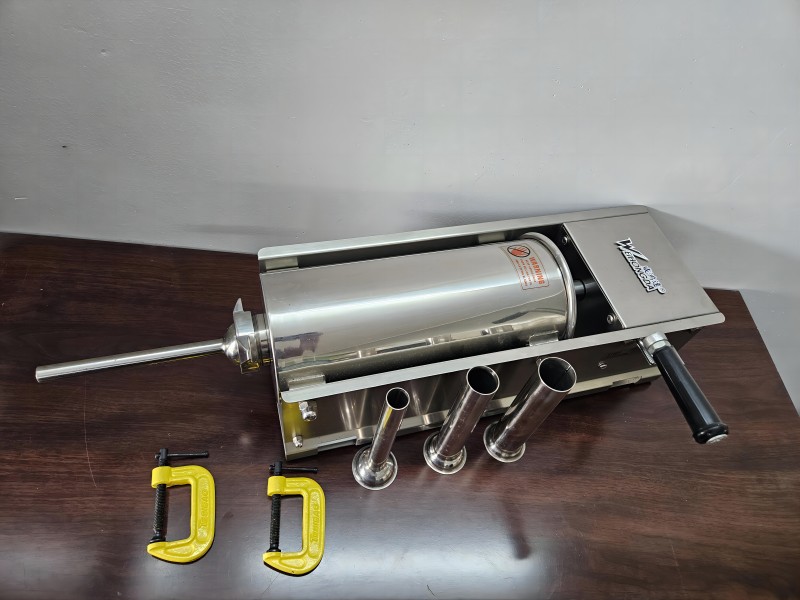Pengantar Pembuatan Sosis
Membuat sosis buatan sendiri telah menjadi tren yang populer di kalangan penggemar makanan dan koki rumahan. Ini bukan hanya tentang kepuasan menyiapkan makanan sendiri, tetapi juga kontrol yang diberikannya terhadap bahan, rasa, dan kualitas. Baik Anda ingin membuat resep tradisional atau bereksperimen dengan rasa baru, membuat sosis di rumah membuka banyak kemungkinan kuliner. Anda dapat menghindari bahan pengawet, memilih potongan daging yang Anda sukai, dan berkreasi dengan bumbu. Namun untuk memulai, Anda harus memiliki alat yang tepat. Di antara mereka, ada mesin pembuat sosis memainkan peran penting dalam merampingkan proses.
Pengertian Mesin Pembuat Sosis
Mesin pembuat sosis adalah tulang punggung perjalanan pembuatan sosis Anda. Mesin ini menyederhanakan tugas mengisi selongsong sosis dan memastikan campuran daging terdistribusi secara merata. Mesin pembuat sosis terdiri dari dua jenis utama: manual dan listrik.
- Pembuat Sosis Manual lebih tradisional, membutuhkan pemutaran dengan tangan untuk mendorong campuran daging ke dalam selongsong. Meskipun mesin ini menawarkan kontrol yang lebih besar atas prosesnya, mesin ini juga membutuhkan lebih banyak usaha fisik.
- Pembuat Sosis ListrikDi sisi lain, mesin ini menawarkan otomatisasi dan kemudahan, menjadikannya ideal untuk produksi dalam jumlah besar atau pembuatan sosis yang sering. Mesin ini mengurangi beban kerja dan menghasilkan sosis lebih cepat daripada mesin manual.
Setiap jenis mesin memiliki keunggulannya masing-masing, tergantung pada kebutuhan, anggaran, dan seberapa sering Anda berencana membuat sosis.
Peralatan Utama untuk Pembuatan Sosis
Meskipun mesin pembuat sosis sangat penting, peralatan lain juga sama pentingnya untuk memastikan hasil terbaik. Berikut ini adalah daftar peralatan yang harus dimiliki untuk membuat sosis yang sukses:
- Penggiling Daging: Di sinilah semuanya dimulai. Menggiling daging dengan konsistensi yang tepat sangat penting untuk membuat sosis. Penggiling berkualitas baik memastikan tekstur yang merata dan mencegah penyumbatan. Carilah penggiling yang menawarkan berbagai ukuran piring untuk keserbagunaan.
- Pengisi Sosis: Setelah daging digiling, langkah berikutnya adalah memasukkannya ke dalam selongsong. Alat pengisi sosis tersedia dalam versi manual dan elektrik, sama seperti alat pembuat sosis. Memilih salah satu yang kokoh dan memiliki beberapa ukuran nosel akan memberi Anda fleksibilitas dalam membuat berbagai jenis sosis.
- Alat Pencampur dan Bumbu: Bumbu yang tepat adalah kunci untuk sosis yang beraroma. Mangkuk pencampur, sendok, dan wadah bumbu harus menjadi bagian dari persiapan Anda untuk memastikan distribusi bumbu dan bahan yang merata.
- Selongsong Sosis: Selongsong bisa terbuat dari bahan alami (berasal dari usus hewan) atau sintetis. Selongsong alami memberikan tekstur dan rasa tradisional, sedangkan selongsong sintetis menawarkan konsistensi dan daya tahan. Pilihannya sering kali tergantung pada preferensi pribadi.
Alat Tambahan yang Meningkatkan Proses
Selain alat-alat penting, beberapa peralatan tambahan dapat meningkatkan pengalaman membuat sosis Anda:
- Termometer Digital: Sosis harus dimasak pada suhu yang tepat untuk memastikan sosis aman untuk dimakan. Termometer digital membantu Anda memantau suhu internal sosis, memastikan hasil yang sempurna setiap saat.
- Timbangan Dapur: Ketepatan sangat penting dalam pembuatan sosis, terutama saat mengukur bahan. Timbangan dapur memastikan Anda menambahkan jumlah daging, lemak, dan bumbu yang tepat untuk mendapatkan profil rasa yang seimbang.
- Pengolah Makanan: Meskipun penggiling daging adalah alat yang tepat untuk membuat sosis, food processor dapat menjadi alat serbaguna untuk menyiapkan bahan-bahan seperti bawang putih, bawang bombay, dan rempah-rempah yang digunakan dalam campuran sosis Anda. Ini menghemat waktu dan memastikan keseragaman.
Pembersihan dan Perawatan Mesin Pembuat Sosis
Merawat peralatan Anda sama pentingnya dengan menggunakannya dengan benar. Karena pembuatan sosis melibatkan daging mentah, kebersihan sangat penting untuk mencegah kontaminasi dan memastikan keamanan makanan.
- Membersihkan Mesin Pembuat Sosis: Setelah digunakan, bongkar mesin dan bersihkan semua bagian secara menyeluruh. Berikan perhatian khusus pada pelat penggiling dan tabung isian, karena partikel daging dapat terperangkap di area ini.
- Kiat untuk Membersihkan Alat Lainnya: Pastikan untuk membersihkan mangkuk, sendok, dan termometer. Selalu ikuti petunjuk produsen untuk membersihkan mesin listrik, karena air dapat merusak motor jika tidak ditangani dengan benar.
Rutinitas pembersihan yang teratur akan memperpanjang masa pakai peralatan Anda dan memastikan sosis Anda selalu aman untuk dimakan.
Memilih Mesin Pembuat Sosis yang Tepat
Memilih mesin pembuat sosis yang tepat bisa jadi sangat membingungkan, mengingat banyaknya model yang tersedia. Namun, dengan berfokus pada beberapa faktor utama dapat membuat keputusan menjadi lebih mudah:
- Ukuran dan Kapasitas: Pikirkan berapa banyak sosis yang akan Anda buat. Mesin yang lebih kecil sangat bagus untuk penggunaan sesekali, sementara model yang lebih besar lebih cocok untuk pembuat sosis yang sering atau mereka yang membuat sosis dalam jumlah besar.
- Fitur: Pertimbangkan fitur tambahan seperti nozel yang dapat disesuaikan, pengaturan kecepatan, dan kemudahan penggunaan. Beberapa mesin dilengkapi dengan alat tambahan untuk membuat berbagai ukuran sosis, sehingga Anda dapat berkreasi secara fleksibel.
- Rekomendasi Anggaran dan Merek: Beberapa merek terkenal di dunia pembuatan sosis termasuk LEM, STX International, dan Weston. Merek-merek ini menawarkan berbagai mesin, mulai dari pilihan yang sesuai dengan anggaran hingga peralatan kelas profesional. Pilihlah mesin yang sesuai dengan anggaran dan kebutuhan Anda.
Kesimpulan: Perjalanan Membuat Sosis Anda Dimulai di Sini
Peralatan yang tepat adalah dasar dari pembuatan sosis yang sukses. Dari penggiling daging hingga pengisi sosis, setiap alat memainkan peran penting dalam memastikan prosesnya lancar, efisien, dan menyenangkan. Dengan mesin pembuat sosis yang tepat, Anda dapat menyelami kerajinan kuliner yang bermanfaat ini, bereksperimen dengan rasa, dan membuat teman dan keluarga terkesan dengan kreasi buatan sendiri. Mesin pembuat sosis memungkinkan Anda menjelajahi kemungkinan tak terbatas di dapur, dan memiliki alat yang tepat akan membuat perjalanan Anda mudah dan menyenangkan. Jadi, mengapa tidak memulai hari ini?
Tanya Jawab tentang Mesin Pembuat Sosis
- Apa jenis mesin pembuat sosis terbaik untuk pemula?
Untuk pemula, pembuat sosis elektrik biasanya merupakan pilihan terbaik karena kemudahan penggunaan dan efisiensinya. Ini meminimalkan upaya manual dan mempercepat prosesnya. - Apakah saya memerlukan penggiling daging jika saya sudah memiliki alat pembuat sosis?
Ya, penggiling daging sangat penting untuk menyiapkan campuran daging. Pengisi sosis hanya mengisi selongsong, sedangkan penggiling memastikan daging dicincang dan dicampur dengan benar. - Berapa lama sosis buatan sendiri dapat disimpan?
Sosis segar buatan sendiri dapat disimpan di lemari es hingga 3 hari atau dibekukan hingga 3 bulan. Pastikan untuk memberi label dan tanggal pada sosis Anda agar tetap segar. - Dapatkah saya membuat sosis tanpa mesin?
Meskipun memungkinkan, membuat sosis tanpa mesin membutuhkan banyak tenaga. Menggunakan stuffer manual atau corong darurat dapat digunakan, tetapi tidak akan memberikan konsistensi yang sama seperti mesin. - Bumbu apa yang penting untuk membuat sosis?
Bumbu yang umum digunakan adalah garam, lada hitam, bawang putih, paprika, dan biji adas. Namun, bumbu yang Anda gunakan akan bergantung pada jenis sosis yang Anda buat dan preferensi selera Anda.

